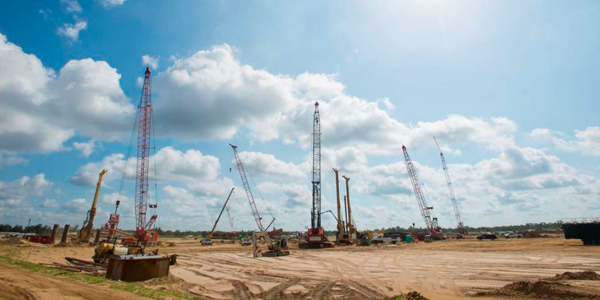By Rich Heidorn Jr. and Michael Brooks
WASHINGTON — A court ruling requiring FERC to consider the impact of greenhouse gas emissions won’t have a “significant” impact on the agency’s licensing of natural gas pipelines, Chairman Neil Chatterjee said Friday.
On Aug. 23, the D.C. Circuit Court of Appeals ruled 2-1 that FERC’s environmental impact statement (EIS) for the Southeast Market Pipelines Project should have included “reasonable forecasting” of the project’s impact on GHG emissions.
FERC had contended that the impact of the pipelines on GHG emissions was unknowable, dependent on variables including the operating decisions of individual plants and regional power demand.
Ruling in a challenge by the Sierra Club, the court said FERC had failed to meet the requirements of the National Environmental Policy Act. FERC “should have either given a quantitative estimate of the downstream greenhouse emissions that will result from burning the natural gas that the pipelines will transport or explained more specifically why it could not have done so,” the court ruled. (See FERC Must Consider GHG Impact of Pipelines, DC Circuit Rules.)
In a press conference Friday, Chatterjee said he didn’t “believe that [the court’s ruling] was going to significantly alter the way that we evaluate these projects.”
Nexus Order
As an example, he pointed to the commission’s Aug. 25 order approving the Nexus Gas Transmission Project, a 255-mile pipeline from Ohio to Michigan (CP16-22) that is being built by DTE Energy and Enbridge’s Spectra Energy. The order contained a lengthy discussion of the environmental impacts of the project, arguing that its analysis complied with the National Environmental Policy Act.
The commission also noted that, in the final days of the Obama administration, EPA had requested the removal of a statement from the project’s EIS that said that there is no accepted methodology for correlating specific GHG amounts to changes in a region’s environment. The agency also asserted that comparing a project’s emissions to statewide emissions did not contribute to an analysis on global climate change.
“The EPA provides no compelling reason to change or supplement the final EIS,” FERC wrote. “The final EIS specifically notes that comparing project-related GHG emissions to statewide GHG inventories provides a frame of reference for understanding the magnitude of GHG emissions in general, but that it does not indicate significance. … The final EIS appropriately discusses climate change, quantifies project-related GHG emissions, identifies emission reduction and mitigation measures and programs, and notes the projects’ consistency with climate goals in the Midwest region.”
“In many ways, that approval anticipated the court’s argument in the Southeast case and addressed a lot of it,” Chatterjee said. He declined to comment on any other projects.
The Sierra Club requested rehearing in the Nexus case, saying the commission’s GHG evaluation failed to meet the D.C. Circuit’s requirement. “Regardless of what methodology FERC ultimately uses, it cannot ignore the issue by claiming, without support, that there is no way fulfill its duty committed to it by NEPA,” Benjamin A. Luckett, senior attorney for Appalachian Mountain Advocates, wrote on the Sierra Club’s behalf.
Southeast Markets’ Supplemental EIS
On Sept. 27, the commission responded to the court’s remand on the Southeast Markets project with a supplemental EIS that included estimated GHG emissions but maintained that the project would have no significant effect on the environment (CP15-16, et al.).
The 685-mile project by Duke Energy, NextEra Energy, Spectra Energy Partners and the Williams Companies, is composed of three interconnected pipelines in Alabama, Georgia and Florida: the Hillabee Expansion Project, Sabal Trail and the Florida Southeast Connection.
FERC’s supplemental EIS concluded that three Florida natural gas generators that would be supplied by the pipelines — Florida Power & Light’s new Okeechobee Clean Energy Center; Duke Energy’s new Citrus County combined cycle plant and FPL’s existing Martin County Power Plant — would emit as much as 12.5 million metric tons of CO2e annually while retirements of coal, oil and natural gas plants replaced by the new units would eliminate 6.14 million metric tons — a net increase of 6.36 million.
Burning of the pipeline’s uncommitted capacity could add an additional 2 million metric tons, FERC said. The net total of 8.36 million metric tons equals 3.7% of Florida’s GHG emissions in 2015, the commission said.
The commission said, however, that it was unable to find a method to “attribute discrete environmental effects” to the emissions. “The atmospheric modeling used by the Intergovernmental Panel on Climate Change, Environmental Protection Agency, National Aeronautics and Space Administration and others is not reasonable for project-level analysis,” the commission said.
FERC also said the social cost of carbon tool is not useful for project-level NEPA review because it does not measure the incremental impacts of a project on the environment. The commission also cited a lack of consensus on the appropriate discount rate and “the monetized values that are to be considered significant for NEPA reviews.”
A group of Albany, Ga., residents responded to FERC’s supplemental filing with a protest, saying “it assumes that coal-burning power plants will be shut down in the future but does not consider the methane output from the many compressor stations that are also planned for these pipelines.”
Other Approvals
On Friday, FERC issued certificates approving two other pipeline projects: the Atlantic Coast Pipeline (CP15-554, et al.), which will deliver up to 1.5 million Dth/d over 604 miles of new pipelines between Harrison County, W.Va., and eastern Virginia and North Carolina; and the Mountain Valley Pipeline (CP16-10, et al.), which will transport up to 2 million Dth/d from Wetzel County, W.Va., to Pittsylvania County, Va.





